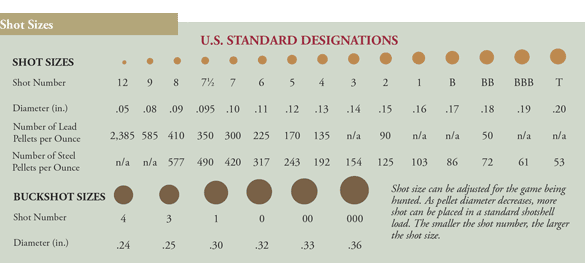


Shotgun Effectiveness: Bring Enough Pellet!
The
adage “bring enough gun” has been around for a good long while.
When it comes to wingshooting, bring enough pellet is something that many
folks could quickly benefit from. The reasons are fundamental; small pellets
can easily cripple when larger pellets will not. Insufficient pellet mass
can cause problems, but larger than minimal never will. Birdshot pellets
aren't large spheres to begin with.

If you look at the shot diameters, you'll see where the "Rule of 17" comes from. For smaller shot sizes like #7 through #1 birdshot, if you subtract the shot # designation from 17 you get the shot diameter in hundredths of an inch. I have no idea how to subtract T or BBB from 17, but that the "Rule of 17" regardless.
Certainly, there is confusion partly because shot sizes are not usually referred to by diameter, but by number. We think of conical bullet diameter in rifles as being meaningful: the notion of caliber is fairly well understood. A .22 rimfire, shooting a 40 grain bullet, is ideal for small pest control or ground squirrels, rabbits, rats, and so forth. The typical .22 rimfire throws that 40 grain projectile at shotshell velocities, often 1200 fps. But, how do you get 40 grains of weight from a lead sphere? There are 437.5 grains to the ounce, meaning one ounce of .22 rimfire projectiles is a little less than 11 bullets. To get that in a sphere, a very poor flying object, it is #1 Buckshot that most closely approximates it as #1 Buck is 11 pellets to the ounce. No. 1 Buck at .30 caliber is huge, tremendously large compared to bird shot. It should help put into perspective why Dr. Martin Fackler has shown that for an HD application, bird shot can get you killed while #1 Buck is ideal.
By comparison with .22 rimfire ammo, birdshot is pathetically light. That's okay, to a degree, as birds are fragile creatures but there is a limit. That limit is quickly reached as ranges increase.

Game farm mallards are hardly the toughest birds ever to hit the air. The most extensive scientific shot tests on live birds was on mallards, though. At ranges from 30 - 80 yards, thousands of mallards donated their bodies to science. The results showed that #4 shot is clearly more effective than #6 shot at all ranges 35 yards and beyond. Based on the typical 1330 fps hunting loads, as shown above, you can compare the penetration into ballistic gelatin at 50 yards.
Larger pellet diameters aren't better because they are larger, they are better due to increased mass. They help in several ways beyond just increased penetration, though penetration is the best barometer of load lethality. Consider the trajectory. The shorthand version of exterior ballistics is "time of flight." All the loads above have the same launch velocity, 1330 fps. As pellet diameter increases, the pellets arrive on target faster. This means less drop, less wind drift, higher impact velocity . . . all good things. You have less drop, drift, and higher impact velocity at all ranges, though it becomes more pronounced as ranges increase. It also shows what a poor flight model the round ball is, as you have over 50% velocity loss at 50 yards even with lead #5 shot, significantly worse with the smallest sizes.
The question comes up quite a bit as to "what you really need." There is, of course, no precise answer as wingshooting is anything but precise. Birds are not clones, they differ in age, weight, and health. Nor are shots truly identical. An incoming shot requires little penetration compared to a raking or going away shot. Perhaps that nervous rooster is a year old, and is flying away from the dog exposing the vitals to you. That next wild pheasant may well be a three pounder, well-feathered, head down, pumping his wings to get away from you and offering you mostly tail feathers and his back to work with. It takes far more penetration to get through a large bird's tail and back, as opposed to a younger bird with exposed head / neck / breast.
That's why the usual, cozy, anecdotal tales are largely meaningless. Just saying, "Hey, it works for me," "It is very effective," or "I haven't had any trouble" doesn't impart any usable information. Unless the bird weight, shot angle, and exact range are documented along with the "It works for me" part, it isn't helpful. I enjoy a good hunting story as much as anyone else, but campfire tales don't help when all you really want is the most appropriate load for the application.
Many, many wingshooters could quickly improve their field success by making one simple change: going up one shot size from what they are using now.
Copyright 2012 by Randy Wakeman. All Rights Reserved.

Custom Search



